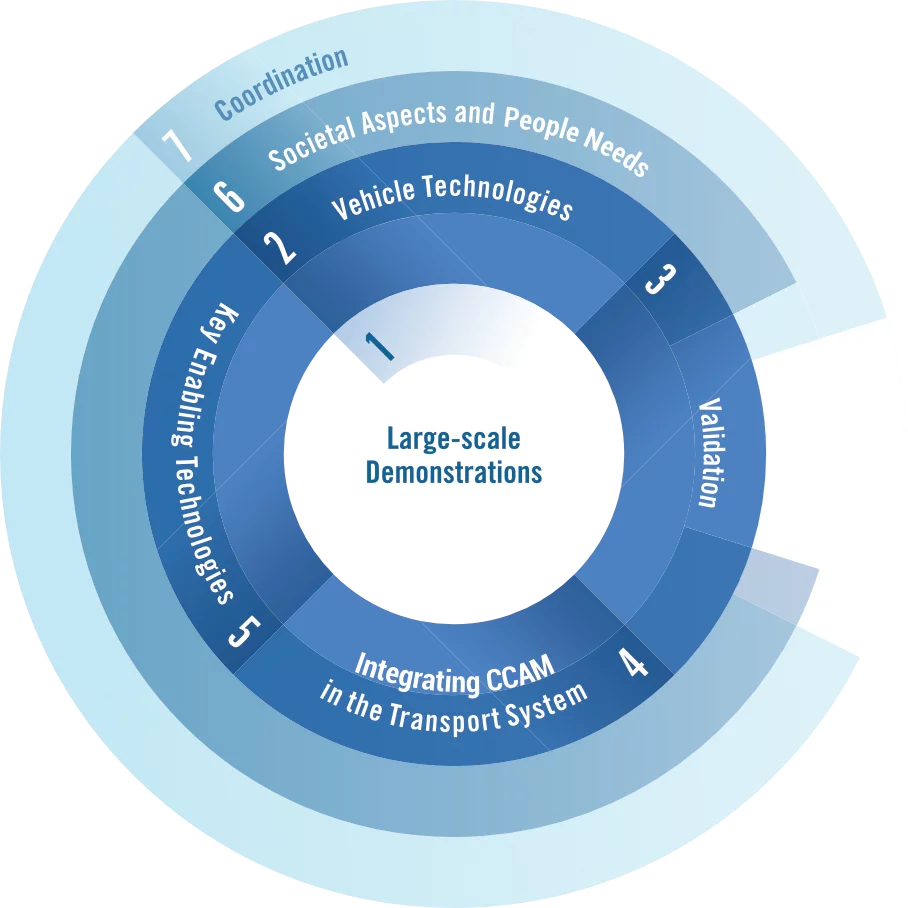What is the CCAM Partnership?
Despite the expected benefits, Connected, Cooperative, and Automated Mobility (CCAM) solutions today are striving to reach the market, due to the existence of different barriers. The lack of societal awareness of the benefits of CCAM-enabled mobility often results in limited demand for the technology. Additionally, the CCAM solutions are still insufficiently mature for the wider market uptake, while current investments in CCAM Research & Innovation (R&I) are inadequate and fragmented lacking a long-term vision. Equally important, demonstrations and scale-ups are also limited since a well-organised, extensive, and complex cross-sectorial value chain is still required to build complete CCAM solutions.
Officially launched on June 23rd, 2021, the CCAM Partnership is a European co-programmed partnership with the goal of accelerating the development, upscale, and implementation of innovative CCAM technologies and services, while ensuring a more user-centred and inclusive mobility system that increases road safety, and limits congestion and environmental pollution. The CCAM Partnership was created to accelerate the innovation pace and implementation of automated mobility by coordinating a wide range of projects within the Horizon Europe framework. It is its ambition to promote more collaborative research, testing, and demonstration projects at the European level, removing barriers to the efficient rollout of automation technologies and services, and developing a coherent, longer-term vision and strategy for targeting systemic solutions.
Today, the CCAM Partnership is organised in 7 clusters (See Fig.1), which structure its activities, organising the necessary R&I actions to ensure advancement in the field, while aligning perspectives from road users and consumers, public policymakers, road operators, and industry. All the clusters are interlinked and provide input to one another, and altogether they form a comprehensive framework for ensuring the future deployment of CCAM solutions.

CCAM ambition and collaboration opportunities
Since its foundation, the CCAM Partnership has set forth an ambitious goal: to conduct large-scale demonstrations of user-oriented and seamlessly integrated CCAM solutions. By 2030, the aim is to establish at least 30 demonstration sites across Europe, showcasing the benefits of efficient and sustainable mobility both for people and goods. These demonstrations will highlight the transformative potential of CCAM technologies in enhancing transportation systems and improving overall mobility experiences. The CCAM Partnership is dedicated to driving innovation and shaping the future of European mobility through these extensive and impactful demonstrations.
Within the framework of the CCAM Partnership, ROADVIEW, together with the sister project EVENTS, has secured funding through one of the first CCAM calls: HORIZON-CL5-2021-D6-01-01. These projects fall under CCAM Cluster 2, Vehicle technologies, and specifically address the need for powerful and reliable on-board perception and decision-making technologies, capable of handling complex environmental conditions. The integration of advanced sensors, control systems, and computational power is crucial for future automated vehicles, ensuring their safety, reliability, and compliance with regulations.
It is in the CCAM Partnership’s vision for the ROADVIEW and EVENTS projects to foster close relationships in their R&I activities, aligning their work to the objectives and Key Performance Indicators (KPIs) of the CCAM Partnership, to overall accelerate the maturation of the technology. Equally important, the Partnership expects ROADVIEW to engage with and provide input to representatives from the FAME project, an initiative that is maintaining the Connected and Automated Driving (CAD) Knowledge Base while developing and validating common methodologies and tools to facilitate the sharing of best practices and lessons across the CCAM value chain. This is an important step to build an efficient cross-sectorial value chain.
Final remarks: why is the CCAM Partnership crucial for ROADVIEW?
Thanks to the active membership of ROADVIEW partners to the CCAM Partnership, the project can benefit from knowledge exchange and networking, standardisation of the ROADVIEW systems, and increased visibility. The CCAM Partnership provides a forum for all the CCAM EU-funded projects, ensuring a high and transparent flow of information. Ad-hoc activities such as the CCAM Multicluster meetings, the EUCAD conference, and various workshops, are organised regularly to provide ROADVIEW partners and their CCAM peers with the opportunity to connect with relevant stakeholders. This collaborative environment fosters knowledge exchange, leveraging on existing data, and paves the way for impactful advancements in CCAM, filling the gaps in the current fragmented R&I landscape, and ultimately leading to better coordination of R&I and large-scale testing activities in Europe.
Moreover, the lack of standardisation, and more specifically the current fragmented value chain, still represents a major barrier to the wider adaption of CCAM solutions. ROADVIEW’s cooperation with the CCAM Partnership ensures that the perception and decision-making systems developed within the ROADVIEW project are compatible with the systems and technology developed within other CCAM projects, as well as with the current regulatory framework, where existing.
Lastly, the CCAM Partnership provides a community for the ROADVIEW project to increase its visibility, raising awareness about the CCAM technologies and the benefits for society at large. Joint events and future collaboration opportunities are assessed periodically. Enhancing the project results visibility is crucial for societal acceptance of the ROADVIEW systems and for the technology uptake once it will have reached maturity.



